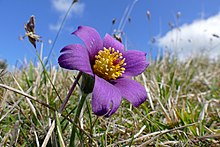Pulsatilla vulgaris
Pulsatilla vulgaris | |
|---|---|
 | |
Conservation status | |
 Near Threatened (IUCN 3.1)[1] | |
Scientific classification | |
| Kingdom: | Plantae |
Clade: | Angiosperms |
Clade: | Eudicots |
| Order: | Ranunculales |
| Family: | Ranunculaceae |
| Genus: | Pulsatilla |
| Species: | P. vulgaris |
Binomial name | |
Pulsatilla vulgaris Mill. | |
Synonyms | |
Anemone pulsatilla L. | |
Pulsatilla vulgaris (pasque flower, pasqueflower, common pasque flower, European pasqueflower, Dane's blood) is a species of flowering plant belonging to the buttercup family (Ranunculaceae), found locally on calcareous grassland in Europe.[2] It was considered part of the Anemone genus, to which it is closely related.[3]
Contents
1 Description
2 Designation
3 Location
4 Additional general information
5 Varieties
6 References
7 External links
Description
This is an herbaceous perennial plant. It develops upright rhizomes, which function as food-storage organs. Its leaves and stems are long, soft, silver-grey and hairy. It grows to 15–30 cm (6–12 in) high and when it is fruit-bearing up to 40 cm (16 in). The roots go 1 m (39 in) deep into the soil. The finely-dissected leaves are arranged in a rosette and appear with the bell-shaped flower in early spring. The purple flowers are followed by distinctive silky seed-heads which can persist on the plant for many months.
The flower is 'cloaked in myth'; one legend has it that Pasque flowers sprang up in places that had been soaked by the blood of Romans or Danes because they often appear on old barrows and boundary banks.[4]
This plant has gained the Royal Horticultural Society's Award of Garden Merit.[5][6]
Designation
It is classified as a Priority Species in the UK Biodiversity Action Plan[7] and as Vulnerable in Britain on the Red Data List.[4]
Location
It grows in sparsely wooded pine forests or meadows, often on a sunny sloping side with calcium-rich soil. A large colony occurs on publicly accessible land in the Cotswolds, at the Gloucestershire Wildlife Trust's Pasqueflower reserve.[8]
Additional general information
It is the county flower of the English counties of Cambridgeshire and Hertfordshire.[9]
Varieties
While the main variety of Pulsatilla vulgaris has purplish flowers; variants include red (Rubra) and white (Alba) forms (see images).

Pulsatilla vulgaris

Pulsatilla vulgaris

Pulsatilla vulgaris rubra

Pulsatilla vulgaris alba
References
^ Schweizer, F. & Hasinger, O. 2014. Pulsatilla vulgaris. The IUCN Red List of Threatened Species 2014: e.T161913A50786112. https://dx.doi.org/10.2305/IUCN.UK.2014-1.RLTS.T161913A50786112.en. Downloaded on 02 December 2016.
^ Shorter Oxford English Dictionary, 6th edition. United Kingdom: Oxford University Press. 2007. p. 3804. ISBN 0199206872..mw-parser-output cite.citation{font-style:inherit}.mw-parser-output q{quotes:"""""""'""'"}.mw-parser-output code.cs1-code{color:inherit;background:inherit;border:inherit;padding:inherit}.mw-parser-output .cs1-lock-free a{background:url("//upload.wikimedia.org/wikipedia/commons/thumb/6/65/Lock-green.svg/9px-Lock-green.svg.png")no-repeat;background-position:right .1em center}.mw-parser-output .cs1-lock-limited a,.mw-parser-output .cs1-lock-registration a{background:url("//upload.wikimedia.org/wikipedia/commons/thumb/d/d6/Lock-gray-alt-2.svg/9px-Lock-gray-alt-2.svg.png")no-repeat;background-position:right .1em center}.mw-parser-output .cs1-lock-subscription a{background:url("//upload.wikimedia.org/wikipedia/commons/thumb/a/aa/Lock-red-alt-2.svg/9px-Lock-red-alt-2.svg.png")no-repeat;background-position:right .1em center}.mw-parser-output .cs1-subscription,.mw-parser-output .cs1-registration{color:#555}.mw-parser-output .cs1-subscription span,.mw-parser-output .cs1-registration span{border-bottom:1px dotted;cursor:help}.mw-parser-output .cs1-hidden-error{display:none;font-size:100%}.mw-parser-output .cs1-visible-error{font-size:100%}.mw-parser-output .cs1-subscription,.mw-parser-output .cs1-registration,.mw-parser-output .cs1-format{font-size:95%}.mw-parser-output .cs1-kern-left,.mw-parser-output .cs1-kern-wl-left{padding-left:0.2em}.mw-parser-output .cs1-kern-right,.mw-parser-output .cs1-kern-wl-right{padding-right:0.2em}
^ RHS encyclopedia of plants & flowers. United Kingdom: Dorling Kindersley. 2010. p. 744. ISBN 1405354232.
^ ab Species detail on the Wildlife Trusts' website
^ "RHS Plant Selector - Pulsatilla vulgaris". Retrieved 30 May 2013.
^ "AGM Plants - Ornamental" (PDF). Royal Horticultural Society. July 2017. p. 82. Retrieved 23 September 2018.
^ Joint Nature Conservation Committee - UK Biodiversity Action Plan. The Committee operates in a statutory advisory capacity to the UK Government.
^ Pasqueflower reserve information on the Gloucestershire Wildlife Trust website
^ "Pasqueflower | Plant & fungi species | Wild plants". www.plantlife.org.uk. Retrieved 2016-01-03.
External links
- Gloucestershire Wildlife Trust
| Wikimedia Commons has media related to Pulsatilla vulgaris. |



